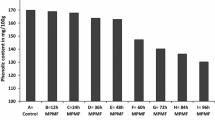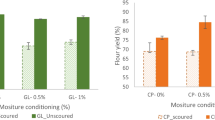Abstract
Four popular West African local cultivars of cowpea (Vigna unguiculata), with distinctly different seed coat colors, were evaluated for their relative amylograph pasting characteristics, condensed tannin content, in vitro protein digestibility and Tetrahymena protein efficiency ratio (t-PER). The effects of roasting and dehulling on these properties were also determined. There were wide variations in the hot paste viscosity characteristics of the different cultivars studied. The raw cowpea flour samples exhibited maximum paste viscosities ranging between 260 Brabender Units (BU) for the Mottled cultivar and 460 BU for the cream-colored Blackeye cultivar. Cowpea cultivars with the greatest peak viscosities showed low stabilities to extended cooking. Roasting depressed paste viscosity properties of all the cowpea cultivars studied. Tannin concentrations were 0.3–6.9 and 7.2–116 mg CE/g flour from whole cowpea seeds and seed coats respectively, increasing with intensity of seed color. Although dehulling removed 98% of the tannin content of raw cowpeas, improvement in protein quality as a result of dehulling was observed for only the highly-pigmented Maroon-red variety. Roasting significantly improved digestibility and more than doubled the t-PER of all cowpea cultivars studied. Roasted cowpeas possess adequate nutritional and functional qualities as protein supplements in cereal-based weaning foods. However, it appears that dehulling is necessary to enhance the nutritional quality of the highly pigmented cultivars of cowpea.
Similar content being viewed by others
References
Dovlo FE, Williams CE, Zoaka L (1976) Cowpeas: Home preparation and use in West Africa. International Development Research Centre, Ottawa, Canada. Bull IDRC - 055e.
McWatters KH, Chhinnan MS (1985) Effect of hydration of cowpea meal on physical and sensory attributes of a traditional West African Food. J Food Sci 50: 444-446.
Ekpenyong TE, Babatunde L, Oyenuga V (1977) Fortification of maize flour based diets with blends of cashewnut meal, African locust bean and sesame oil meal. J Sci Food Agric 28: 710-716.
Plahar WA, Leung HK, Coon CN (1983) Effects of dehydration and soy fortification on physicochemical, nutritional and sensory properties of Ghanaian fermented maize meal. J Food Sci 48: 1255-1259.
Plahar WA, Leung HK (1983) Composition of Ghanaian fermented maize meal and the effect of soy fortification on sensory properties. J Sci Food Agric 34: 407-411.
Plahar WA, Leung HK (1985) Storage stability of dehydrated and soy-fortified fermented maize meal. J Food Sci 50: 182-187.
Nti CA, Plahar WA (1995) Chemical and biological characteristics of a west African weaning food supplemented with cowpea (Vigna unguiculata). Plant Foods Hum Nutr 48: 45-54.
Price ML, Butler LG (1977) Rapid visual estimation and spectrophotometric determinations of tannin content of sorghum grain. J Agric Food Chem 25: 1268-1273.
Price ML, Van Scoyoc S, Butler LG (1978) A critical evaluation of the vanillin reaction as an assay for tannin in sorghum grain. J Agric Food Chem 26: 1214-1218.
Bressani R, Elias LG, Wolzak A, Hagerman AE, Butler LG (1983) Tannin in common beans: Methods of analysis and effects on protein quality. J Food Sci 48: 1000-1003.
Deshpande SS, Cheryan M (1985) Evaluation of vanillin assay for tannin analysis of dry beans. J Food Sci 50: 905-910.
Laurena AC, Garcia VV, Mendoza EMT(1987) Effects of heat on the removal of polyphenols and in vitroprotein digestibility of cowpea (Vigna unguiculata). Plant Foods Hum Nutr 37: 183-192.
Griffiths DW, Moseley G (1980) The effect of diets containing field beans of high or low polyphenolic content on the activity of digestive enzymes in the intestines of rats. J Sci Food Agric 31: 255-259.
Bressani R, Elias LG, Braham JE (1982) Reduction of digestibility of legume proteins by tannins. J Plant Foods 4: 43-55.
Aw T-L, Swanson BG(1985) Influence of tannin on Phaseolus vulgarisprotein digestibility and quality. J Food Sci 50: 67-71.
Price ML, Hagerman AE, Butler LG (1980) Tannin content of cowpeas, chickpeas, pigeonpeas and mung beans. J Agric Food Chem 28: 459-461.
Elias LG, De Fernandez DG, Bressani R (1979) Possible effects of seed coat polyphenolics on the nutritional quality of bean protein. J Food Sci 44: 524-527.
Deshpande SS, Sathe SK, Salunkhe DK, Cornforth DP (1982) Effects of dehulling on phytic acid, polyphenols and enzyme inhibitors of dry beans (Phaseolus vulgarisL.). J Food Sci 47: 1846-1850.
Phillips RD, Adams JG (1983) Nutritional and physiological response of rats to diets containing whole, decorticated and decorticated and steamed cowpeas. Nutr Rep Int 27:949-958.
Laurena AC, Van Den T, Mendoza EMT (1984) Effects of condensed tannins on the in vitroprotein digestibility of cowpea (Vigna unguiculata). J Agic Food Chem 32: 1045-1048.
Plahar WA, Dovlo FE (1986) Consumer preference for cowpea varieties in the Volta and Northern regions of Ghana. A paper presented at the 6th National Maize and Cowpea Workshop. Feb (1986). Crops Research Institute., Kumasi, Ghana.
Shuey WC, Tipples KH (1982) The amylograph handbook. St Paul, MN: American Association of Cereal Chemists.
Adeyemi IA, Osunsami AT, Fakorede MAB (1987) Effect of corn varieties on Ogi quality. J Food Sci 52: 322-324.
Hsu HW, Vavak DL, Satterlee LD, Miller GA (1977) A multienzyme technique for estimating protein digestibility. J Food Sci 42: 1269-1273.
Spackman DH, Moore S, Stein WH (1958) Automatic recording apparatus for use in the chromatography of amino acids. Anal Chem 30: 1190-1206.
Hirs CHW(1967) Determination of cystine as cysteic acid. Methods in enzymology 11: 59-62.
Opienska-Blauth Jr, Charrzinski M, Merbec H(1963) A new rapid method of determining tryptophan. Anal Biochem 6: 69-76.
Subramanian SS, Jambunathan R, Cocon JM, Mertz ET (1970) Simple methods for determining lysine and tryptophan in high lysine and normal maize. Fed Proc 29: 761.
Evancho GM, Hurt HG, Delvin PA, Landers RE, Ashton DH (1977) Comparison of Tetrahymena pyroformis wand rat bioassays for the determination of protein quality. J Food Sci 42: 444-448.
Dryden MJ, Kendrick JG, Satterlee LD, Schroeder LJ, Block RG (1977) Predicting protein digestibility and quality using an enzyme-Tetrahymena pyriformis wbioassay. J Food Biochem 1: 35-44.
Steel RGD, Torrie JH (1980) Multiple Comparison. In ‘Principles and Procedures of Statistics’, 2nd edn, p 172. New York: McGraw-Hill.
Banigo EOI, DeMan JM, Duitschaever CL (1974) Utilization of high-lysine corn for the manufacture of Ogi using a new, improved processing system. Cereal Chem 51: 559-572.
Ferrel RE, Pence JW(1964) Use of amylograph to determine extent of cooking in steamed rice. Cereal Chem 41: 1-9.
FAO/WHO/UNU (1985) Energy and protein requirements. Report of a joint FAO/WHO/UNU Expert Consultation. Geneva: WHO, Technical Report Series, No. 724.
Author information
Authors and Affiliations
Rights and permissions
About this article
Cite this article
Plahar, W.A., Annan, N.T. & Nti, C.A. Cultivar and processing effects on the pasting characteristics, tannin content and protein quality and digestibility of cowpea (Vigna unguiculata). Plant Foods Hum Nutr 51, 343–356 (1997). https://doi.org/10.1023/A:1007994612607
Issue Date:
DOI: https://doi.org/10.1023/A:1007994612607




